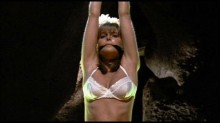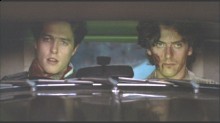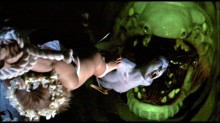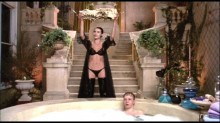The Lair of the White Worm was the final novel by Bram Stoker of Dracula fame, and while the 1911 book is no Dracula, it does have marked vampiric similarities. This was perhaps what drew Ken Russell to the novel—as a kind of consolation prize for his thwarted plans to film Dracula. Whatever attracted Russell to the material, his 1988 film of Stoker’s book proved to be one of the director’s most accessible works and introduced him to an entire new generation of fans. It’s easy to understand why, since The Lair of the White Worm is an almost perfect savvy blend of horror and comedy that both honors the horror genre while standing it on its head.

On the surface this may seem to be fairly lightweight Ken Russell. Certainly, the deliberately campy story—Lady Sylvia Marsh (Amanda Donohoe) and the vampiric high priestess of an ancient snake cult that dates back (as does she) to the time of Roman occupation of England—is not the weightiest of material. And there’s no question that Russell has highlighted its every possible absurdity—note that on both occasions when she’s about to do something pompously ritualistic, Lady Sylvia gets brought back to earth by some vexing mundane matter. This, after all, is a movie where one hero, Lord James D’Ampton (an almost pubescently young Hugh Grant), is the epitome of Noel Coward Britishness and the other, Angus Flint (Peter Capaldi), is a Scottish archaeology student, who occasionally sports a kilt, plays bagpipes and has a sporran spacious enough to house a mongoose. It is also a movie where the title monster is partly made out of the front of a Volkswagen Beetle.

Essentially then, this a fun horror picture—with bouts of cheekily unrealistic gore and a fair degree of skin. There would be more skin, but Catherine Oxenberg’s contract had a “no nudity” clause, so she appears rather improbably garbed in industrial strength underwear as Lady Sylvia’s virgin sacrifice to the giant white worm. Amanda Donohoe was rather more relaxed about it, seemingly ready to disrobe in the twinkling of an eye—and paint herself blue if the scene required it (and a couple of them indeed do).

The overall tone of the film is something like an episode of The Avengers, with Amanda Donohoe as a kind Emma Peel (Diana Rigg) gone very wrong indeed. In keeping with this, she drives about in a 1960s E Type Jaguar (which has the added advantage of rather resembling a snake’s head). At the same time, Hugh Grant goes about the countryside in a Morgan— a Brit sports car with a body style that has looked about the same since the 1930s. Everything about the film is crafted to suggest that it takes place in some vaguely past era—or that it exists in a realm where time is strangely unfixed.

Beneath this surface, however, is a film that is just about as subversive as anything Russell ever made—maybe more so because it can go unnoticed. As is often the case with Russell, there’s a central conflict concerning religion. In this case, it’s Christianity vs. a pagan cult. Thing is the forces of good seem a lot less appealing than the forces of darkness. Because of the context, a scene of Lady Sylvia spraying venom on a crucifix goes unremarked, and fantasy scenes of Roman soldiers raping nuns (busty nuns at that) while Jesus Christ is attacked by a giant white snake on the crucifix seem to bother no one. It’s all context, because if these scenes had been in Russell’s The Devils (1971), chances are they’d have been censored. And where most horror films end with a happy boy-and-girl climax or a suggestion of evil unvanquished, Russell offers us, well, something a bit different with a homoerotic undercurrent.

Make of it what you will. The Lair of the White Worm works as horror film/horror-film spoof. It works on a deeper level if you want to go there. It can be a simple tale of valiant knights attempting to save ladies fair from the clutches of the monstrous villainess and her equally monstrous monster. For Russell fans, it’s full of in-jokes and references to other films. Two Russell regulars—Christopher Gable and Imogen Clair—show up in minor roles. Ken and his then wife Vivian can be seen walking past in an early scene (Ken cries out, “Hello, Mary!” to Sammi Davis). He also provides the voice of the constable with the flat tire on other end of the walkie-talkie conversation. The film gets close to being a backyard sort of production in its off-handedness. In fact, the scene where Sammi Davis and Peter Capaldi walk home at night was illuminated by light from Ken’s kitchen window. Oh, yeah, one more thing—Ken Russell is personally terrified of snakes.
The pre-show entertainment this week will consist of Chapter Four of the Bela Lugosi serial The Return of Chandi, “The Evil Eye,” and the Betty Boop cartoon “I’ll Be Glad When You’re Dead, You Rascal You.” Those start about 7:40 p.m., so be early.




Aside from the historical interest of seeing a Hugh Grant who’s barely out of short trousers, fans of THE THICK OF IT and IN THE LOOP might be interested to see Peter Capaldi (the guys who plays Malcolm Tucker, not related to the drummer from Traffic).
Jeremy – Don’t you mean fans of “Local Hero” can see where Capaldi finally turned up again after too long a wait? Myself, my favorite scene in this one is where Grant valiantly lobs a sword in a most Arthurian manner against a creature most foul and, carried on by his momentum, proceeds to keep spinning and crashes into his drumkit. Oh yeah, and the mouth organ scene.
Hanke – Have you heard anything about a portion of the new Green Lantern movie being shot near Lake Lure? A producer friend of mine in Atlanta said it was rumored.
Have you heard anything about a portion of the new Green Lantern movie being shot near Lake Lure?
No, I haven’t.
I just finished watching this strange film … didn’t read your review, Mr. H, until just after the end credits.
Must admit that I wasn’t as impressed with this film as I was after the closing scene for ‘The Devils’. Still, these scenes that seem in some dreamscape, e.g. the snake attacking the son of man on the cross, the nuns under attack by Roman soldiers, the the sister being ravaged … it all reminded me of Altered States-Eddie Jessup’s religious imagery on the shroom juice.
Still … I found Lady Sylvia Marsh up in a tree awaiting Eve very sinister and an incredibly disturbing idea on Mr. Russell’s part.
As a side note, google the vignette from the Sistine Chapel fresco by Michelangelo – viz. the expulsion of Adam and Eve.
Check out the feminine snake-like figure wrapped around the Tree. Is this a strange coincidence or what?
Must admit that I wasn’t as impressed with this film as I was after the closing scene for ‘The Devils’
I would indeed have been surprised if you had. I’d say the overall aims of the two films are somewhat different.
Oh, yes, the fantasies definitely owe more than a little something to Altered States.
I’ll have to take a gander at that vignette (my memory of it is dim). There’s a very good chance this is not coincidence.
Again … having not read your review beforehand, I expected not to see instances of comedy in a horror film, at least on Mr. Russell’s part. The Devils and Altered States are indeed two of my favorites by him. Both are much more serious in their stories. My view of horror has been greatly influenced by Russell and those dreamscape moments.
Maybe I was just expecting more from this … still liked it though.